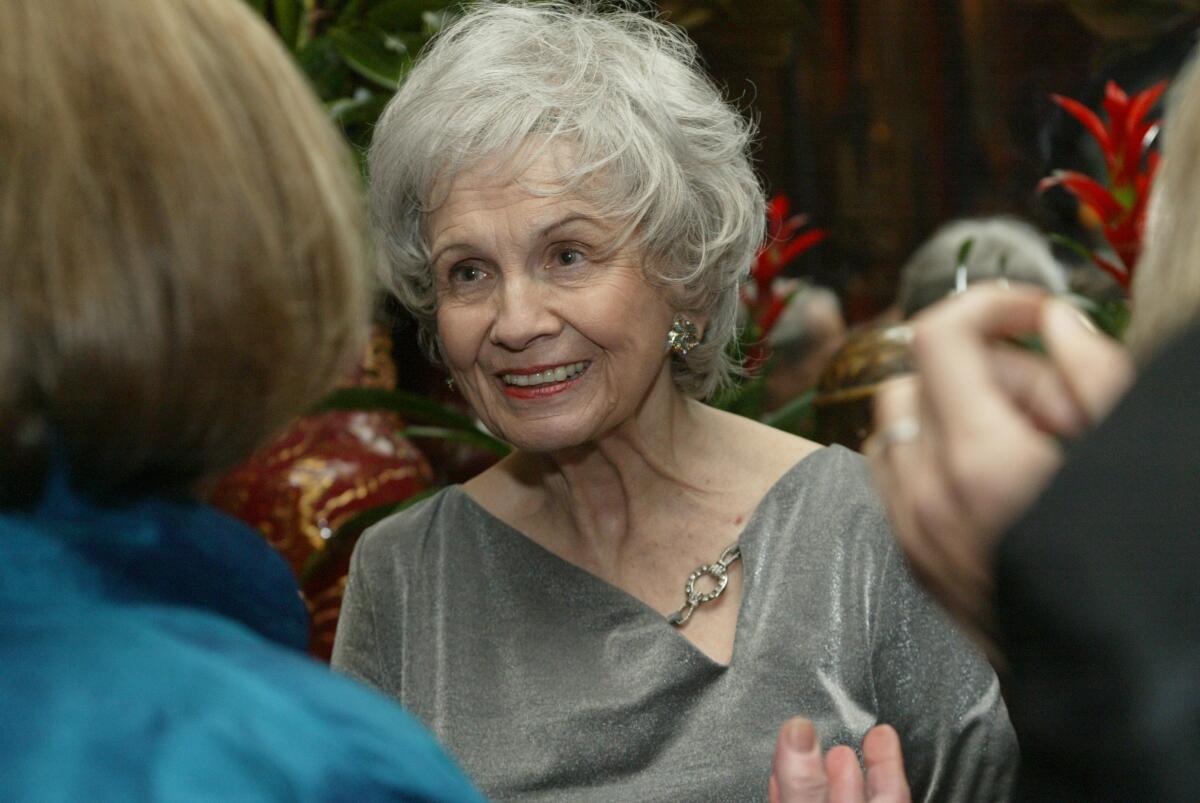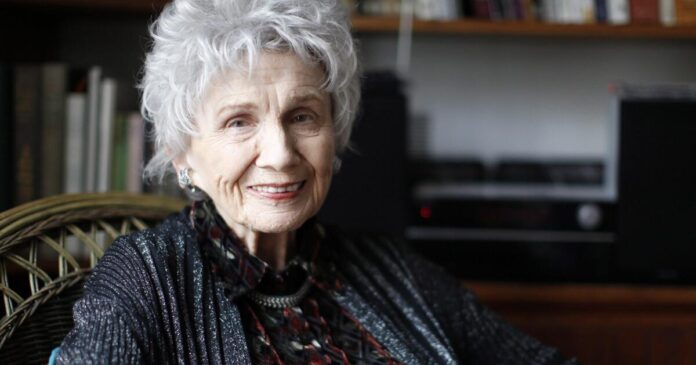Alice Munro, the Canadian quick story author who lent mythic proportions to the lives of odd folks from small, rural cities like these within the Ontario countryside the place she spent most of her life, has died. She was 92.
A spokesperson for the writer’s writer confirmed the dying of Munro however didn’t instantly present additional particulars, the Related Press reported Tuesday. She had been in frail well being since present process coronary heart surgical procedure in 2001.
Thought-about by many to be the best quick fiction author of her era, Munro was awarded the Nobel Prize in literature in 2013, solely months after publishing a group of tales that she mentioned can be her final. She had already obtained the Man Booker Worldwide Prize, the Nationwide E book Critics Circle Award in america and each high literary prize supplied in her native Canada, together with its most prestigious, the Governor Basic’s Award.
“Alice Munro is our Chekhov, and goes to outlast most of her contemporaries,” writer Cynthia Ozick mentioned some years in the past, evaluating her to Russia’s nineteenth century grasp of the quick story. Reviewers typically linked the 2 writers’ names, partly as a result of each had mastered a refined peeling again of layers to disclose their characters.
Munro wrote about nation people who knew tips on how to intestine a turkey, breed foxes and promote medication door to door, but additionally knew about unreliable love, household violence and failed makes an attempt at social climbing. Her tales unfold, typically within the fictional cities of Jubilee or Hanratty, with a direct simplicity paired with painstaking craftsmanship. She made no secret of the handfuls of drafts it took her to finish a narrative.
“She’s grow to be a virtuoso,” writer John Updike, the literary critic for the New Yorker, mentioned in a 2001 interview with the Montreal Gazette. “She manages to get into folks’s pores and skin with out seeming to dive in, with out being ostentatious.”
A number of of Munro’s collections had been fabricated from linked tales the place characters leap throughout years or many years earlier than the final web page. In “Lives of Women and Ladies” (1971), she recognized a few of her favourite type of ladies. They had been “boring, easy, wonderful and unfathomable — deep caves paved with kitchen linoleum.”
She as soon as defined her attraction to such lives, saying they solely seem like boring. “The complexity of issues, the issues inside issues, simply appears to be countless,” Munro mentioned. “I imply, nothing is straightforward, nothing is easy.”
Her greatest works evaluate with basic tragedy written in prose type.
“I wish to inform a narrative within the old school means — what occurs to someone,” Munro mentioned in a 1998 Classic Books interview. “However I need the reader to really feel one thing is astonishing. Not the ‘what occurs’ however the way in which all the things occurs.”
There aren’t many blissful endings in Munro tales. However there may be fundamental goodness, clearly uncovered, in almost all of her characters. In the event that they lose, they often lose in love, and carry their disappointments with quiet dignity.
“The bleakness of its imaginative and prescient is enriched by the writer’s beautiful eye and ear for element,” Joyce Carol Oates wrote within the New York Occasions in 1986. “Life is heartbreak, however additionally it is uncharted moments of kindness and reconciliation.”
Munro attracted worldwide consideration with out ever leaving dwelling. She lived most of her life in rural Ontario, surrounded by woods and farmland. She famous in interviews that she was raised on the unsuitable facet of the tracks in her hometown of Wingham. As a younger woman she may hardly wait to get away from that life, however years of writing fiction set in small cities modified her view.
“I’m at dwelling with the brick homes, the falling-down barns, the occasional farms which have swimming swimming pools and airplanes, the trailer parks, burdensome previous church buildings, Wal-Mart, and Canadian Tire,” Munro wrote within the introduction to “Chosen Tales” (1996). “I converse the language.”
She vaulted into the mainstream by sheer pressure of will. More and more she was included within the lofty league along with her buddy Margaret Atwood in addition to Carol Shields and Timothy Findley, Canada’s main fiction writers amongst her contemporaries.
She referred to herself as compulsive and pushed about her work. She wrote day-after-day and set the very best targets. As a newbie within the early Nineteen Fifties she submitted her work to the New Yorker and was rejected time and again. Her first story for the journal was revealed in 1979. After that she grew to become a frequent contributor.

Alice Munro obtained the Nationwide Arts Membership’s thirty seventh Medal of Honor for Literature in 2005.
(Diane Bondareff / Invision / Related Press)
Daniel Menaker, who was Munro’s editor on the New Yorker and later the editor in chief at Random Home, referred to her as “a contemporary and experimental author within the clothes of a classical author.”
“You get the sensation she’s making an attempt that can assist you get at some true emotional psychological perception,” Menaker mentioned in a 2003 interview with the Guardian. As typically as not, he mentioned, it results in “a darkish existential uncertainty about what makes folks tick.”
Born Alice Laidlaw on July 10, 1931, and raised on a fox and mink farm, a failing household enterprise, Munro was the oldest of three kids. Her mom, Anne, was a stickler for “pure” and ladylike conduct, which cramped Alice’s creativeness.
Anne Laidlaw developed Parkinson’s illness when Alice was 10. Lengthy-term sickness solely made their strained relationship worse. Alice left dwelling at 17, torn by guilt, and didn’t return dwelling over the last two years of her mom’s life.
In “The Peace of Utrecht” (1959), she described a younger lady who goes dwelling after her mom’s dying. She is defiant however not completely convincing concerning the selection she made to go away.
The story, certainly one of Munro’s first blatantly autobiographical works, freed her. From then on she wrote private tales, a quantity together with uneasy mother-daughter relationships.
“The issue, the one downside, is my mom,” she wrote within the autobiographical “The Ottawa Valley” (1997). “She is the certainly one of course that I’m making an attempt to get. … To mark her off, to explain, to illumine, to rejoice, to do away with her.”
When Munro did depart dwelling, it was to attend the College of Western Ontario. There she met her future husband, James Munro, they usually married in 1951. The couple moved to Vancouver, the place he labored as an govt at a division retailer. That they had three kids, Sheila, Jenny and Andrea. One other woman, Catherine, was born with out kidneys and died hours later.
Whereas her kids had been younger, Munro wedged fiction writing between home tasks and her daughters’ naps. Time constraints steered her towards quick tales. “I wrote in bits and items,” she mentioned in a 2001 interview with Atlantic Month-to-month. “Maybe I obtained used to pondering of my materials when it comes to issues that labored that means.”
In 1963 the Munros moved to Victoria, British Columbia, and opened a bookstore — Munro’s Books — which ultimately grew to become a literary landmark.
Household commitments slowed Munro’s writing profession. It took her shut to twenty years to complete sufficient tales to fill her first assortment, “Dance of the Blissful Shades,” revealed in 1968. She was 37. The guide received the Canadian Governor Basic’s Literary Award in 1969. Munro received the prize once more in 1978, 1979 and 1987.
“I really feel that I’m two quite totally different folks, two very totally different ladies,” she mentioned in an interview with Graeme Gibson for “Eleven Canadian Novelists” (1973). “In some ways I desire a fairly conventional function after which in fact the author stands proper exterior this, so there’s the battle proper there.”
The social upheavals of the Sixties gave Munro new materials to write down about. She grew dissatisfied along with her husband, and the couple divorced in 1973 after 22 years of marriage. She took an appointment educating on the College of Western Ontario and reconnected with Gerald Fremlin, a geographer she first met whereas they had been college students. They married and in 1976 moved to Clinton, Ontario; every had been raised inside just a few miles of the city.
Place grew to become a personality in Munro’s tales. “I’m intoxicated by this panorama,” she wrote, “by the virtually flat fields, the swamps, the hardwood bush, by the continental local weather with its extravagant winters.”
In dozens of quick tales set in Ontario, she mixed the “intractably rural” area with the human commotion it hosted — “gothic passions, buried sorrows and forlorn mysteries,” a reviewer for the New York Occasions journal wrote in 2004.
At age 60, Munro started writing tales about her contemporaries as they seemed again over the previous. In “Good friend of My Youth,” a group revealed in 1990, various women and men from Munro’s era are portrayed as grudging survivors of the sexual revolution, the peace motion and the feminist motion of the Sixties and ’70s. Critics referred to her “mature imaginative and prescient.”
By 1998 Munro was on the peak of her success. She received the Nationwide E book Critics Circle Award that yr for “The Love of a Good Lady.” Three years later, she accomplished “Hateship, Friendship, Courtship, Loveship, Marriage,” her twelfth guide. It sealed her repute. She adopted it in 2004 with “Runaway,” a group of three tales that comply with the principle character, Juliet, from a bumbling 21-year-old with a level in classics by way of 30 years of dangerous amorous affairs, cash issues and a daughter who not speaks to her.
“The moments she’s pursuing now … are moments of fateful, irrevocable, dramatic motion,” Jonathan Franzen wrote in a assessment for the New York Occasions E book Evaluate. “What this implies for the reader is you possibly can’t even start to guess at a narrative’s which means till you’ve adopted each twist; it’s at all times the final web page or two that switches all of the lights on.”
Munro’s closing story assortment, “Pricey Life,” was revealed in 2012. The next yr, she received the Nobel Prize in Literature.
“I write the story I wish to learn,” Munro instructed the New York Occasions. “I don’t really feel accountable to my readers or my materials. I understand how exhausting it’s to get something to work proper. Each story is a triumph.”
Munro is survived by her daughters Sheila and Jenny. Fremlin, her husband, died in 2013.
Rourke is a former Occasions workers author.














